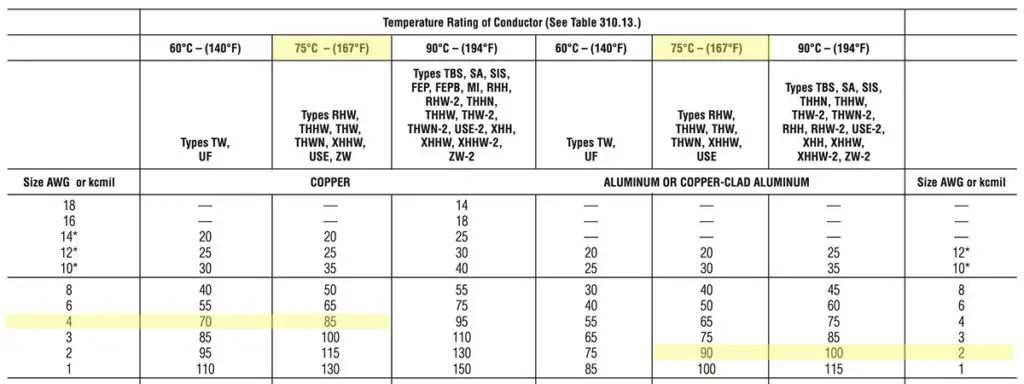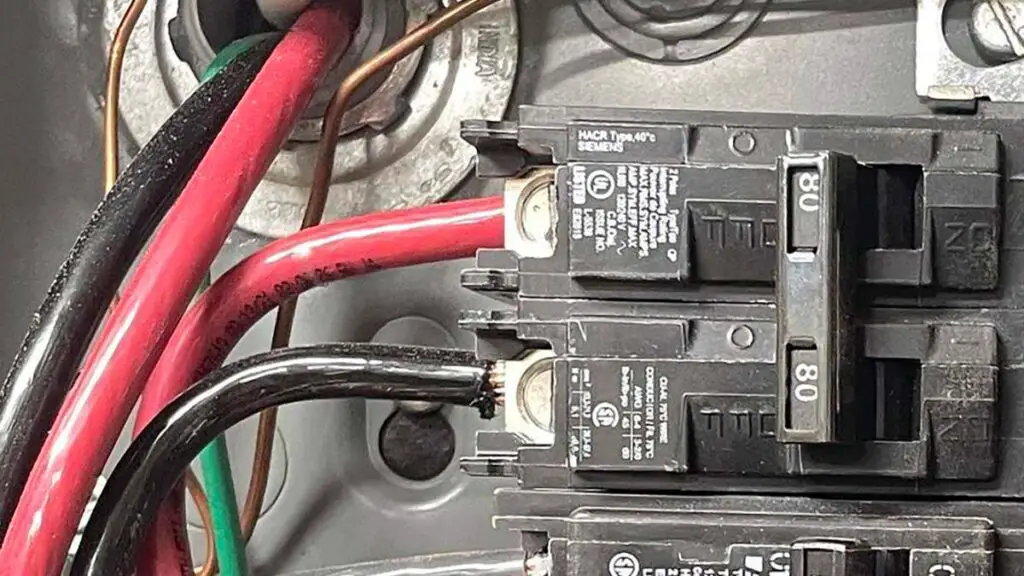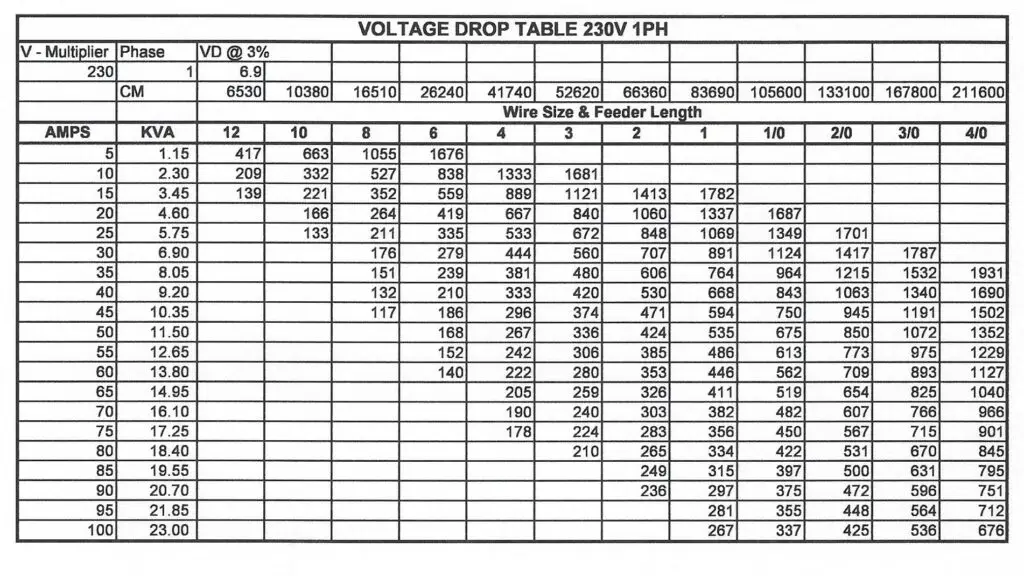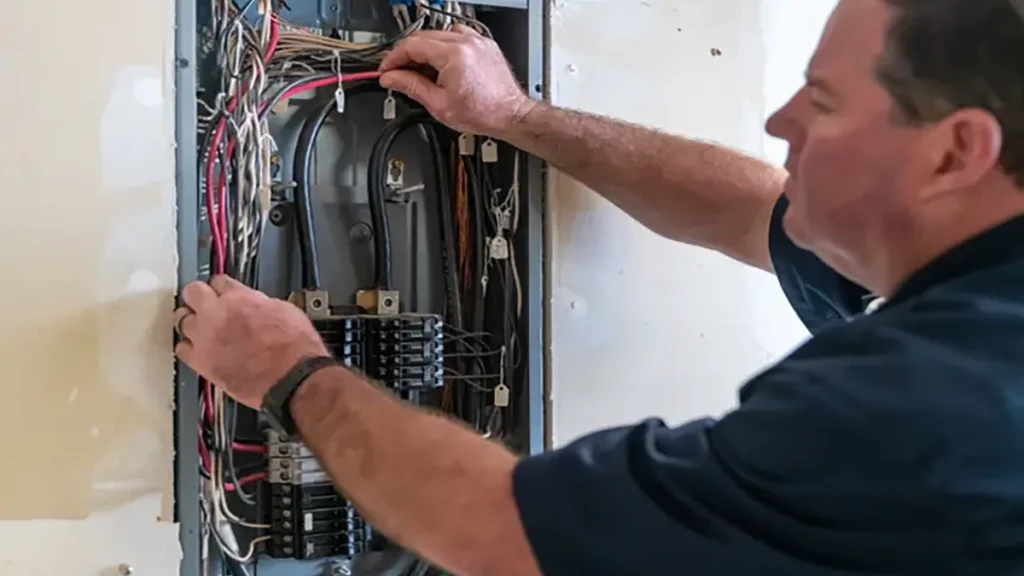According to the National Electrical Code (NEC), an 80 amp wire size is 4 AWG copper or 2 AWG aluminum wire gauge at 75o C (167o F) and within 100 ft. 1

To account for wire length, temperature, and voltage drops, you may need to increase the 80 amp circuit to a 3 or 2 AWG copper or 2 or 1 AWG aluminum or copper-clad wire. They ensure that your industrial or commercial equipment receives stable, safe power, from motors and pumps to large-scale lighting systems and HVAC units.
Always consult NEC Table 310-16 guidelines and use a voltage drop calculator to ensure safety and efficiency.

Determining the Right Wire Size for 80 Amp Circuits
When you’re sizing wire for an 80 amp circuit, it’s like setting the stage for a flawless performance of your electrical system. The wire you choose becomes the silent hero, ensuring every connected piece of equipment operates without a hitch. But how do you determine the best wire size? It’s a blend of science, standards, and a bit of savvy.
Factors Affecting Wire Size Selection
- Material Matters: The debate between copper and aluminum is not just about cost. With its superior conductivity and durability, copper wire is often the go-to choice for its lower voltage drop and higher ampacity. Aluminum wire, while more cost-effective, requires a larger gauge to carry the same amount of current as copper.
- Distance Plays a Role: The length of your wire run can significantly impact voltage drop. The longer the distance, the larger the wire size you’ll need to ensure your equipment gets the power it needs without significant loss.
- Voltage Drop Considerations: Speaking of voltage drop, it’s not just an inconvenience. It’s a performance and safety issue. Using a voltage drop calculator helps you understand how your wire size can affect the efficiency of your electrical system, especially in long runs.
- Temperature Tells a Tale: Your wire’s ambient and insulation temperature ratings can influence performance. Wires in hot environments or running through insulated spaces may need to be upsized to handle the increased resistance of higher temperatures.
- Understanding Ampacity: The ampacity of a wire defines its safe current-carrying capacity. NEC tables and an ampacity calculator can be invaluable tools, ensuring you adhere to safety standards and choosing a wire that can handle your circuit’s demands without overheating.
If you plan to install an 80 amp circuit, it is important to understand the electrical calculations involved to ensure the circuit is safe and efficient. In this section, we will discuss some of the key considerations when calculating electrical requirements for 80 amp circuits.
Voltage Drop Considerations
One of the key considerations when calculating electrical requirements for an 80 amp circuit is voltage drop. Voltage drop is the reduction in voltage that occurs as electricity travels through a wire.
This reduction in voltage can cause electrical devices to malfunction or fail altogether. Choosing the right size wire for your circuit is important to avoid voltage drop.
Distance and Wire Size
The distance between the power source and the electrical device also affects the wire size needed for an 80 amp circuit. The longer the distance, the larger the wire size required.
This is because larger wires have less resistance, which reduces the voltage drop over long distances. Choosing the correct wire size for your circuit is important to avoid voltage drop and ensure your devices receive the correct power.

Using a Wire Size Calculator
Calculating the correct wire size for an 80 amp circuit can be complicated. Fortunately, many online wire size calculators are available to help you determine the correct size wire for your circuit.
These calculators consider factors such as the length of the circuit, the voltage, and the amperage to choose the right wire size.
When using a wire size calculator, it is important to ensure that you are using accurate information. Make sure that you know the correct voltage and amperage of your circuit, as well as the length of the circuit.
Using a wire size calculator ensures that your 80 amp circuit is safe, efficient, and meets all electrical requirements.
Wire Size Chart and Table for 80 Amp Service
Equipped with the knowledge of what affects wire size, you’re now ready to consult the charts—the maps that guide you through the landscape of wire sizing. These charts aren’t just tables; they’re your blueprint for ensuring that every amp your circuit delivers is done safely and efficiently.

For example, in the chart above, a 3 AWG copper wire length can extend up to 210 feet. You will need a 1/0 AWG aluminum wire to extend the same 210 feet.
Navigating the Chart
The wire size chart for an 80 amp service is more than a list; it’s a tailored guide that considers the nuances of your specific setup. It considers the type of wire (copper or aluminum), the maximum temperature your wires will be exposed to, and the length of your run. Here’s how you can use this invaluable tool:
- Identify Your Wire Material: Start by selecting copper or aluminum. Remember, copper carries more current with a smaller gauge compared to aluminum.
- Consider the Length of Your Run: Longer runs require larger wire sizes to compensate for voltage drop. This ensures that the power at the end of the line is sufficient for your needs.
- Account for Temperature: Check your wire’s insulation temperature rating and its environment’s ambient temperature. Higher temperatures may require you to go up a gauge to maintain performance and safety.
- Consult the Chart: With your parameters in hand, consult the chart. Find the row that matches your wire material and the column that aligns with your run length and temperature conditions. The number where they meet is your recommended wire size.
Understanding the Chart
The wire size chart is not just a reference; it’s a reflection of your commitment to safety and efficiency. It’s a tool that takes the guesswork out of electrical installations, ensuring that every amp delivered is done so with precision. By adhering to the chart, you’re following guidelines and setting the standard for excellence in your electrical installations.
Related reading: 200 Amp Wire Size: Service Length & Wiring Gauge Guide
Applications of 80 Amp Breakers
80 Amp breakers are versatile, serving various residential, commercial, and industrial needs. Here’s how they’re commonly used:
- Residential Electrical Panel: Powers large appliances like electric stoves, water heaters, or high-power electric dryers.
- Subpanel Distribution: Manages power distribution in larger residential or commercial spaces.
- Industrial and Commercial Applications: Protects circuits powering machinery, HVAC systems, or heavy-duty electrical loads.
- Large-scale Lighting Installations: Supports stadiums, theaters, and concert venue lighting systems.
- Dedicated Circuits: Ideal for commercial refrigeration units, industrial ovens, lighting installations, EV charging stations, large motors, pumps, compressors, welding equipment, HVAC systems, and high-amp data center equipment.
Understanding Wire Size and Ampacity

Wire Size Basics
Wire size refers to the diameter of the wire and is measured in American Wire Gauge (AWG). The smaller the gauge number, the larger the wire diameter. The wire size is important in determining the maximum amount of current that can safely flow through the wire, known as the ampacity.
Related reading: 70 Amp Wire Size: Breaker & Wiring Gauge Guide
Types of Cables for 80 Amp Breakers
Both copper and aluminum cables are used with 80-Amp breakers, with the choice depending on the specific application and environment. Here are the most popular types:
- THHN/THWN (Copper and Aluminum): Widely used in residential panels, subpanels, commercial installations, refrigeration units, and HVAC systems.
- XHHW (Aluminum/Copper): Common for industrial equipment like motors, pumps, and compressors.
- MC Metal-Clad Cables: Offer extra mechanical protection, often used with large-scale lighting systems.
- SER Service Entrance Cable: Connects 80 amp circuit breakers in residential panels and subpanels.
- USE-2 (Underground Service) and Triplex and Quadruplex URD Cables: Suitable for underground 80 Amp installations where allowed or required.
Each cable type is chosen based on specific properties, like temperature resistance or mechanical protection, ensuring the 80 Amp breaker system is safe, efficient, and tailored to the application’s needs.
Determining Ampacity
Several factors, including the wire size, conductor material, insulation type, and circuit length, determine a wire’s ampacity. The ampacity can be found in the National Electrical Code (NEC) tables, which provide guidelines for safe wiring practices.
To determine the proper wire size for a circuit, you need to calculate the ampacity required by the load and compare it to the ampacity of the wire. If the ampacity of the wire is less than the ampacity necessary, you need to use a larger wire size.
Copper vs Aluminum Wires
Copper wires are less resistant than aluminum wires so they can carry more current without overheating. They are also more durable and less likely to break or corrode over time. However, copper wires are more expensive than aluminum wires.
Aluminum wires, on the other hand, are cheaper and lighter than copper wires. They are also easier to work with because they are more malleable. However, aluminum wires have a higher resistance than copper wires, which means they can overheat if not sized correctly. They are also more prone to corrosion and can break more easily than copper wires.
Heat and Resistance Factors
When selecting wires for an 80 amp circuit, it is important to consider the heat and resistance factors. The heat generated by the current passing through the wire can cause the wire to melt or become damaged. The resistance of the wire can also cause it to heat up and become damaged.
Choosing wires that are sized correctly for the circuit is important to minimize the risk of overheating and damage. The American Wire Gauge (AWG) system is used to determine the size of the wire. The larger the AWG number, the smaller the wire. For an 80 amp circuit, a 4 AWG copper wire or a 2 AWG aluminum wire would be appropriate.
In addition to choosing the correct size wire, it is also important to use wire rated for the appropriate temperature. Wires are rated based on the maximum temperature they can safely operate at. For an 80-amp circuit, a wire rated at least 75°C should be used.
Installation and Safety
When it comes to installing an 80-amp circuit, there are a few things you need to keep in mind to ensure proper installation and safety. Let’s discuss proper installation techniques, overheating and safety precautions, and choosing the correct breaker.
Proper Installation Techniques
It is important to follow proper installation techniques to ensure that your 80-amp circuit is installed correctly. This includes using the correct wire size, providing that the wire is properly grounded, and using the right circuit breaker.
It is also important to ensure that all connections are tight and secure and that there are no loose wires.
You should hire a qualified electrician to install your 80-amp circuit. They have the knowledge and expertise to ensure your circuit is installed correctly and safely.
- Safety First: Before you begin, ensure all power is turned off at the source. Safety goggles, insulated gloves, and proper tools are your best friends in preventing accidents.
- Respect the Insulation: The insulation on your wires is not just a cover; it’s a protector. Avoid nicking or cutting the insulation; exposed wires can lead to short circuits or electrical fires.
- Secure Connections: Whether connecting to a terminal, a junction box, or an amp breaker, ensure your connections are tight and secure. Loose connections can lead to arcing, overheating, and potential hazards.
- Avoid Overcrowding: Wires need breathing room. Overcrowded conduits can lead to overheating and reduced performance. Ensure your wires have enough space to dissipate heat effectively.
- Mind the Bend Radius: Wires are flexible, but they have their limits. Sharp bends can damage the wire and impact its performance. Always adhere to the manufacturer’s recommended bend radius.
- Grounding is Paramount: Never underestimate the importance of proper grounding. It’s your primary defense against electrical shocks and system malfunctions.
- Labeling is Helpful: Label your wires at both ends. It’s a simple step that can save you time and confusion during troubleshooting or future upgrades.
- Test Before Use: Once everything is connected, test your setup with a multimeter or a similar testing device. Ensure there’s proper voltage and no signs of short-circuiting before you consider your job done.
Overheating and Safety Precautions
Overheating is a common problem with circuits that are not installed correctly. It is important to ensure the wire size is correct and the circuit is not overloaded to prevent overheating. Overloading can cause the circuit to overheat, leading to a fire.
It is also important to take safety precautions when working with electricity. Always turn off the power before working on a circuit, and use insulated tools to avoid electric shock. If you are not comfortable working with electricity, it is best to hire a qualified electrician to do the work for you.
Choosing the Right Breaker
Choosing the correct breaker is crucial to the safety and performance of your 80-amp circuit. The breaker should be rated for 80 amps and compatible with your electrical panel. It is important to choose a high-quality breaker to ensure that it can handle the load and provide reliable protection.
When choosing a breaker, it is important to consider the type of circuit you are installing. For example, a 240-volt circuit will require a double-pole breaker, while a 120-volt circuit will require a single-pole breaker.
Specific Applications and Devices
Regarding 80 amp wire size, several applications, and devices require amp wire size for optimal performance. Let’s discuss some of the most common applications and devices that require 80 amp wire size.
Residential Applications
In residential settings, 80 amp wire size is typically used for electrical service. This wire size is necessary to handle the electrical load of the entire house. It is also commonly used for electric water heaters, furnaces, motors, pumps, air conditioners, and sump pumps.
If you plan to install any of these appliances or devices in your home, it is important to ensure that the wiring is done correctly and that the wire size is appropriate for the electrical load.
Commercial and Industrial Uses
In commercial and industrial settings, 80 amp wire size is used for various applications. It is commonly used for motors, pumps, air conditioners, and other large electrical equipment. It is also used for electrical service in commercial buildings.
In addition, 80 amp wire size is used for appliances and equipment in commercial kitchens, such as ovens and refrigerators.
Choosing the correct wire size for the application is important for electrical wiring. Using the wrong wire size can result in overheating, electrical fires, and other safety hazards.
Frequently Asked Questions
What gauge of wire is required for an 80 amp circuit at 240 volts?
To determine the correct wire gauge for an 80 amp circuit at 240 volts, consider the wire run length, the type of wire, and the ambient temperature. A general rule of thumb is to use a 3-gauge copper wire for a 240-volt circuit. Consult the National Electrical Code (NEC) or a licensed electrician to determine the appropriate wire gauge.
What is the appropriate aluminum wire size for an 80 amp load?
If you use aluminum wire for an 80 amp load, you should use 1 AWG wire. This is based on the NEC’s ampacity chart, which lists 1 AWG aluminum wire as having an ampacity of 80 amps. For longer runs, consider using a 1/0 AQG aluminum wire.
Can a 4 gauge wire support an 80 amp current safely?
According to the NEC wire size charts, a 4-gauge copper wire can sometimes safely support an 80 amp current. Depending on wire length, temperature, and voltage drops, you may need to increase the wire gauge to 3 or 2 AWG. A licensed electrician can help you determine the appropriate wire size.
How does the 80% amp load limit affect wire size selection?
The 80% amp load limit is a safety standard that ensures your wires operate well within their capacity, preventing overheating and potential hazards. The maximum continuous load on your wire should not exceed 80% of its ampacity. For an 80 amp circuit, this translates to a maximum continuous load of 64 amps. Selecting a wire size that adheres to this limit is crucial for maintaining a safe and efficient electrical system.







